Victoria Memorial
When was it built: Built between 1906 to 1921
Who built it: Conceptualised by George Curzon, Viceroy of India
Where is it located: Kolkata, West Bengal, India
Why was it built: To commemorate Queen Victoria
Architectural Style: Indo-Saracenic revivalist style
Visiting Hours: 10am-5pm (Monday-Sunday)
How to Reach: Located in the metro city of Kolkata which is well-connected with several national and international cities.
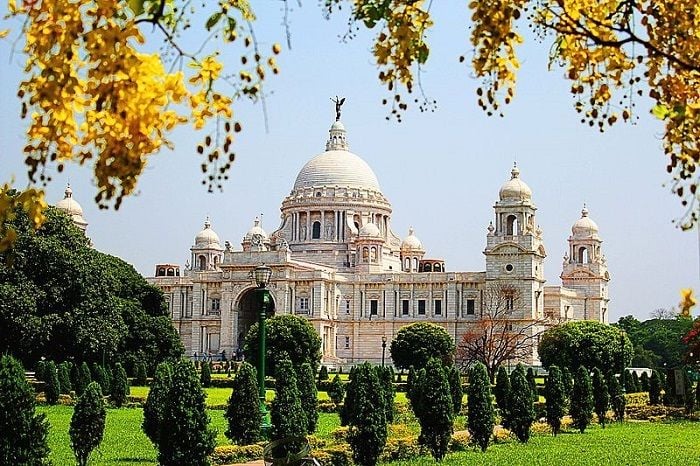
Image Credit:
The Victoria Memorial, a huge monument made of white marble located in the heart of the City of Joy, Kolkata (erstwhile Calcutta) in West Bengal, India is one of the most famous monuments in West Bengal that has become a museum and popular tourist spot of the state. A brainchild of George Curzon, 1st Marquess Curzon of Kedleston and Viceroy of India, this monument epitomising beauty and elegance was dedicated to the memory of Queen Victoria (1819–1901). This grand and exquisite memorial not only stands as reminiscence to the rule of British Crown in the Indian subcontinent but also stands out as an excellent architectural gem in Indo-Saracenic revivalist style. It is a must visit tourist destination for first time visitors to experience the essence of Victorian era in the midst of the bustling metro city of Kolkata.
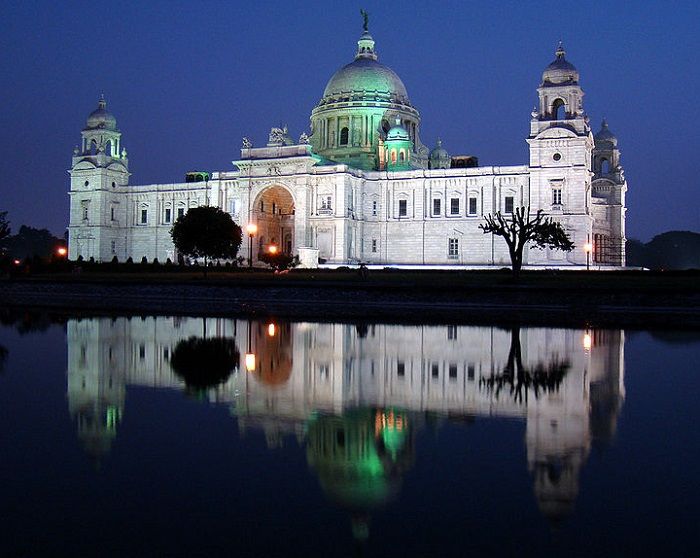
Image Credit : Wikipedia.org
History
Queen Victoria who remained Queen of the United Kingdom of Great Britain and Ireland since June 20, 1837 and Empress of India since May 1, 1876 passed away on January 22, 1901. Following her demise, Lord Curzon conceived the idea of constructing a colossal and grand building with a museum and gardens where one and all can have a glimpse of the rich past. The foundation stone of the monument was laid on January 4, 1906 by the Prince of Wales George V who later became King George V on May 6, 1910. In 1921, the memorial was opened to public; however it became part of a provincial city instead of the capital city as by the time its construction completed, the capital of India was transferred from Calcutta to New Delhi under the instruction of King George V. An appeal made by Curzon to fund the construction of the memorial saw many including royals, individuals as well as the British government in London to come forward and contribute voluntarily. The total cost of building the memorial came to Rs. 105, 00,000..
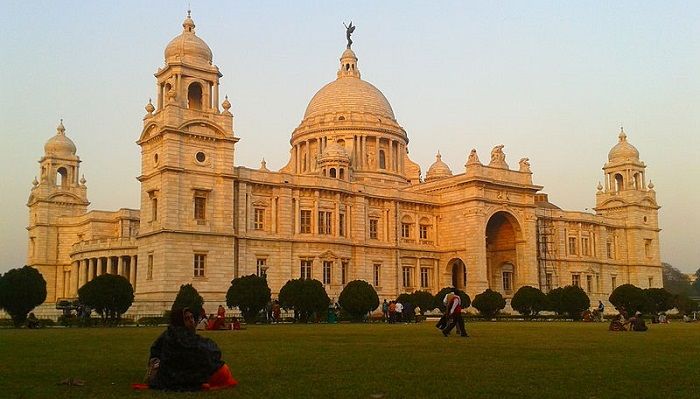
Image Credit :Wikipedia.org
Construction & Architecture
William Emerson, the then president of the Royal Institute of British Architects was the chief architect of the memorial that was designed in Indo-Saracenic revivalist style. The style encompassed a blend of British architectural style with that of Egyptian, Venetian, Deccani, Mughal and other Islamic styles. Build of Makrana marble brought from Jodhpur, Rajasthan, it measures 103 m by 69 m with a height of 56 m. Scottish physician and botanist Sir David Prain and Lord Redesdale were entrusted to design the vast garden areas covering 64 acres while garden gates and the bridge of the north aspect were designed by Vincent J. Esch. Messrs. The garden is presently maintained by a group of 21 gardeners. Martin & Co. of Calcutta carried out the construction work of the memorial. Certain additions were made to the memorial post independence of India.
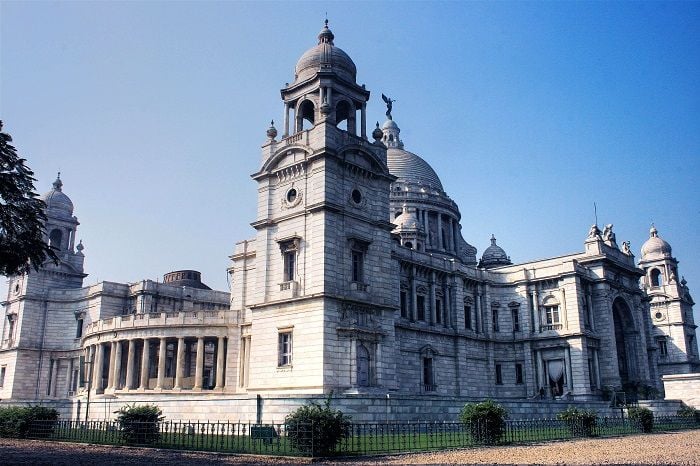
Image Credit : Wikipedia.org
Attractions
There are 25 galleries inside the memorial including the royal gallery, the sculpture gallery and the Calcutta gallery among others. Several portraits of Queen Victoria and her husband Prince Albert of Saxe-Coburg and Gotha and oil paintings portraying different moments of their lives are displayed in the royal gallery. The newer addition was the Calcutta gallery, concept of which was advocated in the mid 1970s by the then minister for education, Saiyid Nurul Hasan. He became Governor of Bengal and Odisha as also Chairman of the memorial’s Board of Trustees in 1986 and in 1992 the Calcutta gallery was opened. One can have a sneak peek of the yesteryear Calcutta and its gradual development through the visual displays of the gallery starting from the days of Job Charnock during the 17th century to 1911 when New Delhi replaced Calcutta as India’s capital. Another addition, the National Leader's gallery displays relics and portraits associated with Indian independence.
It is a house of remarkable collections of paintings, artefacts, weapons, textiles, coins and stamps among others and maintains few possessions of the Queen like her writing desk and chair and scrapbooks. Rare collection of books is preserved here like the Rubaiyat by Omar Khayyam and masterpieces of William Shakespeare.

Image Credit : Wikipedia.org
Attractions
There are 25 galleries inside the memorial including the royal gallery, the sculpture gallery and the Calcutta gallery among others. Several portraits of Queen Victoria and her husband Prince Albert of Saxe-Coburg and Gotha and oil paintings portraying different moments of their lives are displayed in the royal gallery. The newer addition was the Calcutta gallery, concept of which was advocated in the mid 1970s by the then minister for education, Saiyid Nurul Hasan. He became Governor of Bengal and Odisha as also Chairman of the memorial’s Board of Trustees in 1986 and in 1992 the Calcutta gallery was opened. One can have a sneak peek of the yesteryear Calcutta and its gradual development through the visual displays of the gallery starting from the days of Job Charnock during the 17th century to 1911 when New Delhi replaced Calcutta as India’s capital. Another addition, the National Leader's gallery displays relics and portraits associated with Indian independence.
It is a house of remarkable collections of paintings, artefacts, weapons, textiles, coins and stamps among others and maintains few possessions of the Queen like her writing desk and chair and scrapbooks. Rare collection of books is preserved here like the Rubaiyat by Omar Khayyam and masterpieces of William Shakespeare.
On the marble staircase at the entrance of the memorial is a bronze statue of Queen Victoria seated on a bronze throne wearing robes of the Star of India. Other statues around the building include that of Edward VII, Curzon, Dalhousie and Hastings among others. Another attraction of the memorial is the Angel of Victory, a black bronze angel placed atop its dome. Fixed to its pedestal with ball bearings, the Angel of Victory with a bugle in her hand rotates as wind blows strongly. Several allegorical sculptures like Justice, Motherhood, Architecture, Learning and Prudence in and around the dome enhance the British aura of the place.
Events
It holds regular Light & Sound (Son-et-Lumiere) shows except on Mondays, Holi, national holidays and during July to September. Rate of tickets are Rs. 10/- and Rs.20/-. The show timings are as under:
March-June – From 6.45 pm to 7.30 pm in Bengali and from 7.45 pm to 8.30 pm in English
October-February – From 6.15 pm to 7.00 pm in Bengali and from 7.15 pm to 8.00 pm in English
October-February – From 6.15 pm to 7.00 pm in Bengali and from 7.15 pm to 8.00 pm in English
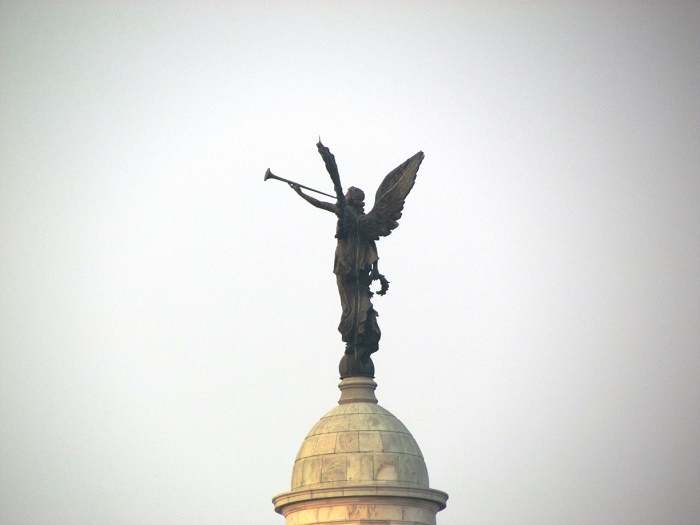
Image Credit:
Visiting the Memorial
Over the years the memorial has not only emerged as one of the most famous tourist destinations of Kolkata but has also remained a favourite spot for family and friends apart from holding a special place for lovebirds. As night falls, lighting of the Victoria Memorial makes it look even more mesmerizing.
Over the years the memorial has not only emerged as one of the most famous tourist destinations of Kolkata but has also remained a favourite spot for family and friends apart from holding a special place for lovebirds. As night falls, lighting of the Victoria Memorial makes it look even more mesmerizing.
One can visit the museum of Victoria Memorial Hall from 10.00 am to 5.00 pm on week days excluding Monday. It remains closed on Republic Day, Holi, Independence Day, Id-ul-Fitr, Gandhi Jayanti, Dusserah and Christmas. Entry fee per person to the museum is Rs. 10/- for Indians and Rs. 150/- for foreigners. Entry is free for uniformed school children up to 12 years of age and for uniformed army personnel.
Garden area of the memorial remains open for visitors round the year from 5.30 am to 7.00 pm. Entry ticket per person is Rs. 4/- (Daily), Rs. 100/- (Monthly) and Rs. 1000/- (Yearly). However visitors may be restricted entry to the garden by order of the authority.

0 Comments